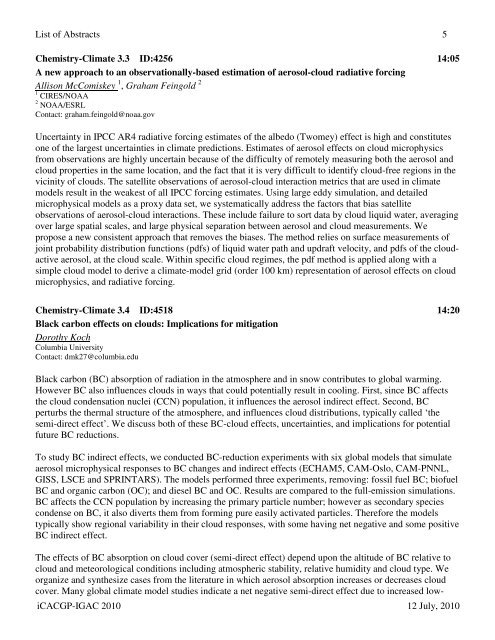Download Abstracts Here - IGAC Project
Download Abstracts Here - IGAC Project
Download Abstracts Here - IGAC Project
Create successful ePaper yourself
Turn your PDF publications into a flip-book with our unique Google optimized e-Paper software.
List of <strong>Abstracts</strong> 5Chemistry-Climate 3.3 ID:4256 14:05A new approach to an observationally-based estimation of aerosol-cloud radiative forcingAllison McComiskey 1 , Graham Feingold 21 CIRES/NOAA2 NOAA/ESRLContact: graham.feingold@noaa.govUncertainty in IPCC AR4 radiative forcing estimates of the albedo (Twomey) effect is high and constitutesone of the largest uncertainties in climate predictions. Estimates of aerosol effects on cloud microphysicsfrom observations are highly uncertain because of the difficulty of remotely measuring both the aerosol andcloud properties in the same location, and the fact that it is very difficult to identify cloud-free regions in thevicinity of clouds. The satellite observations of aerosol-cloud interaction metrics that are used in climatemodels result in the weakest of all IPCC forcing estimates. Using large eddy simulation, and detailedmicrophysical models as a proxy data set, we systematically address the factors that bias satelliteobservations of aerosol-cloud interactions. These include failure to sort data by cloud liquid water, averagingover large spatial scales, and large physical separation between aerosol and cloud measurements. Wepropose a new consistent approach that removes the biases. The method relies on surface measurements ofjoint probability distribution functions (pdfs) of liquid water path and updraft velocity, and pdfs of the cloudactiveaerosol, at the cloud scale. Within specific cloud regimes, the pdf method is applied along with asimple cloud model to derive a climate-model grid (order 100 km) representation of aerosol effects on cloudmicrophysics, and radiative forcing.Chemistry-Climate 3.4 ID:4518 14:20Black carbon effects on clouds: Implications for mitigationDorothy KochColumbia UniversityContact: dmk27@columbia.eduBlack carbon (BC) absorption of radiation in the atmosphere and in snow contributes to global warming.However BC also influences clouds in ways that could potentially result in cooling. First, since BC affectsthe cloud condensation nuclei (CCN) population, it influences the aerosol indirect effect. Second, BCperturbs the thermal structure of the atmosphere, and influences cloud distributions, typically called ‘thesemi-direct effect’. We discuss both of these BC-cloud effects, uncertainties, and implications for potentialfuture BC reductions.To study BC indirect effects, we conducted BC-reduction experiments with six global models that simulateaerosol microphysical responses to BC changes and indirect effects (ECHAM5, CAM-Oslo, CAM-PNNL,GISS, LSCE and SPRINTARS). The models performed three experiments, removing: fossil fuel BC; biofuelBC and organic carbon (OC); and diesel BC and OC. Results are compared to the full-emission simulations.BC affects the CCN population by increasing the primary particle number; however as secondary speciescondense on BC, it also diverts them from forming pure easily activated particles. Therefore the modelstypically show regional variability in their cloud responses, with some having net negative and some positiveBC indirect effect.The effects of BC absorption on cloud cover (semi-direct effect) depend upon the altitude of BC relative tocloud and meteorological conditions including atmospheric stability, relative humidity and cloud type. Weorganize and synthesize cases from the literature in which aerosol absorption increases or decreases cloudcover. Many global climate model studies indicate a net negative semi-direct effect due to increased low-iCACGP-<strong>IGAC</strong> 2010 12 July, 2010








